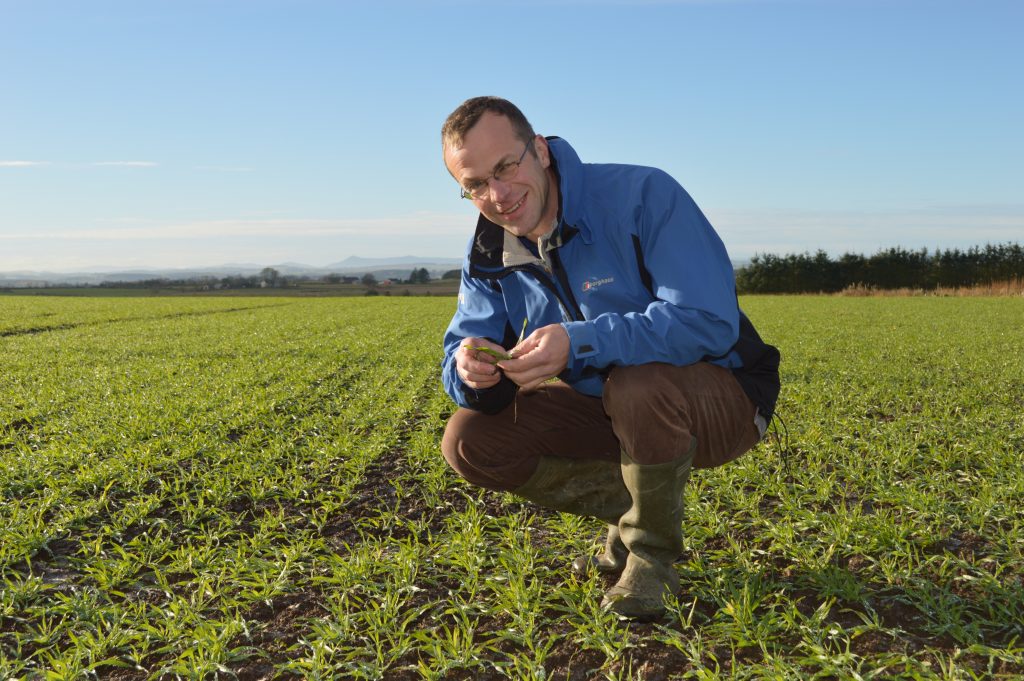Top tips for getting the most out of spring barley – Farmers Guardian – Iain Learmonth
With drilling around the corner, Farmers Guardian explores key considerations for spring barley crops this season, whatever the end market ...
As spring approaches, now is a good time to be making decisions on which spring barley variety to grow, says Aberdeenshire-based Hutchinsons agronomist, Iain Learmonth.
But whether growing for malting, brewing or feed, the market can be fickle, so securing the target market is important, he says.
“Plan ahead rather than hope someone will buy your crop and it is always important to talk to your merchant.”

Iain Learmonth
One of the consequences of Covid-19 during 2020, was the impact on the hospitality sector which resulted in a glut and a high carry-over of malting barley.
Most maltsters only accept certain varieties, so doing your homework and finding the right variety that will work both for your farm system and your customer is key, says Mr Learmonth.
“Opting for a dual-purpose variety with both brewing and distilling markets makes sense as it gives you more options and still compares well with out-and-out feed varieties on yield.
“This means if at the end of the day your crop is not accepted for malting or distilling, you will not get hit on yield in the way you would be with the lower yielding varieties.”
Nitrogen
Addressing concerns that different agronomic practices are required according to the end use of the spring barley crop, Mr Learmonth says that if it is aimed at low nitrogen malting, it would normally receive less N than optimum for yield, to make sure it hits the customer’s specification.
The nitrogen rate to achieve the required N specification for malting or brewing, will vary between farms and between seasons.
“Growers should use on-farm experience and grain N results from previous years as a starting point, and then adjust the rate depending on target market requirements, drilling date, soil N and N supply from organic sources,” he says.
“Seed rates and drilling strategy would not vary, and the rest of the agronomy strategy will be very similar, whatever your final market, because the variety will have a similar disease profile.”
Whether you opt for brewing, distilling or feed, a healthy crop with good green leaf retention is key to yield and profit, so timely fungicide applications remain crucial, independent of where the crop is going, and can impact on gross margin, Mr Learmonth adds.
“If you decide you want to push for the highest yield, you will need to apply a plant growth regulator. However, it will need to be chosen carefully as some PGR’s can impact on screenings if the crop is going for malting.”
Mr Learmonth also recommends using trace elements where necessary, if low levels are detected.
“We use tissue and grain testing to check for any deficiencies. In this area, manganese, copper and magnesium are generally required, so are applied routinely in two or three applications through the season.”
In the field Peter Chapman, Aberdeenshire
Yield is king for Aberdeenshire family farmer, Peter Chapman, who grows spring barley for feed.
He has been applying organic manures for 30 years, which paid dividends in 2020. A yield of 9.7 tonnes/hectare won him Gold in the recent Yield Enhancement Network (YEN) competition, for his crop of LG Diablo spring barley.
Mr Chapman says: “The feed barley market suits us well, as we like to push for yield so we go for gold.”
He and his wife run a 420ha mixed farm, comprising 340ha of arable crops, with the remainder being used for grazing his 70 suckler cows.
Key to his success is the attention to detail he pays to the fertility of the soils and every year the soil receives farmyard manure, compost, or bought-in chicken muck.
He says: “We grow feed barley, and this system suits us very well. With the manure, it would be likely that we would get a late flush of N in June, so growing spring barley for malting would not be an option.”
After harvesting, the crop is dried and stored, and he sells the barley from November onwards.
The farm is extremely well placed for his target market; Mr Chapman’s main customer is his uncle, who is almost on the doorstep and purchases between 80-90 per cent of his production. In addition, the ports of Peterhead and Aberdeen are close by, so any excess is well located for export.
Most of the spring barley straw is baled and used for the farm’s herd of Aberdeen-Angus crosses.
“We have been growing LG Diablo for two years. We chose it because it is one of the highest yielding spring barley varieties on the current AHDB Recommended List.”
He also likes the variety’s good all round agronomy package, and highlights that it stands well and has good brackling resistance.
“It is slightly late maturing, but this means that it fits well with the other spring barleys we grow,” Mr Chapman says.
Gross margins from growing LG Diablo are good, and last year he achieved £740-£825/ha.
“This works well for us and we push for yield. In the YEN we really pushed the crop and we achieved 87 per cent of its total potential.”